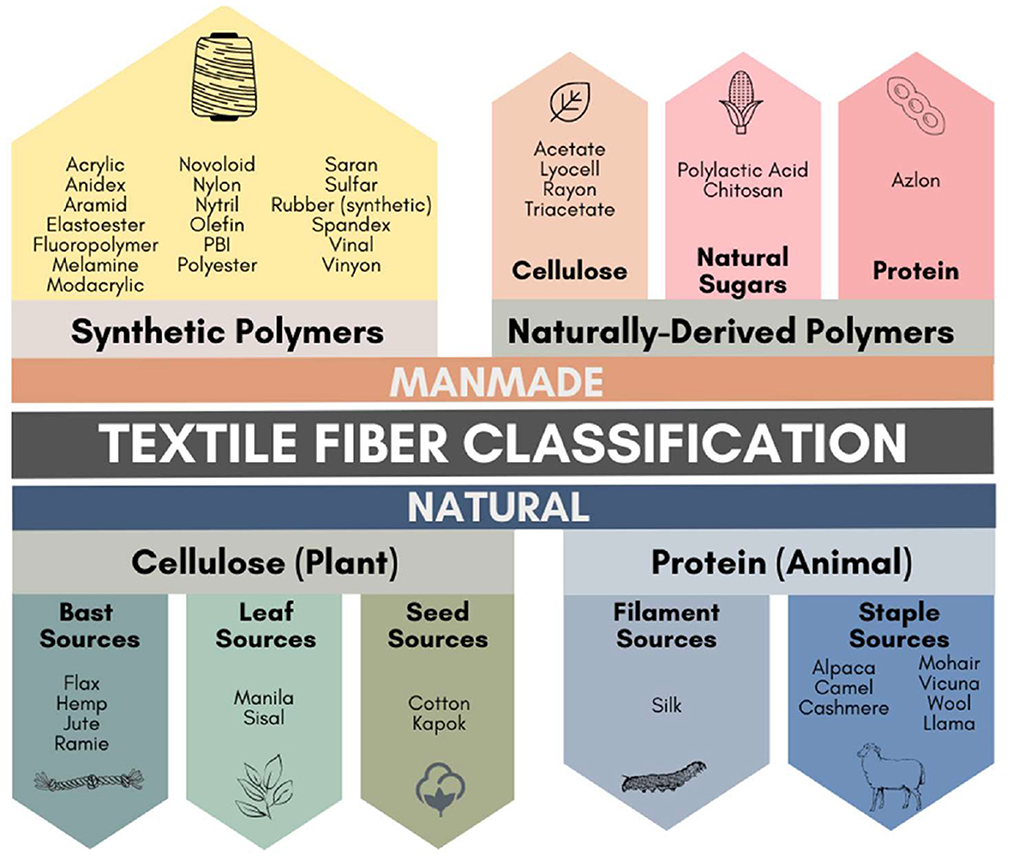You can read about wool here.
You can read laundry tips here.
Over two-thirds of today's garment production is based on synthetic materials like polyester, nylon, or acrylic. Different synthetics have different qualities that make them more or less suitable for different uses. The purpose of this post is to explain some of the main qualities of the most popular synthetics found in clothing as well as the positive and negative sides of the material. Following the figure below, this post will focus on the pentagon of "synthetic polymers."
Based on the information from "Physical Properties of Textile Fibers (2008)" by W. E. Morton and J. W. S. Hearle. Illustration by Schumancer & Foster (2022).
Benefits of synthetic polymers
The use of synthetic fibers in clothes was introduced to the market in the 1930s as women's hosiery. New types quickly followed; spandex hit the market; then nylon, and so on. Synthetic fabrics were instantly enjoyed as they eased up women's housework by being easy to care for and a high-performing material. It was a part of the technological revolution after the second world war that freed up more time so more women were able to enter the workforce. Today, the use of synthetic fibers has skyrocketed and we draw both pros and cons from its usage.
⇾ Easy care (wash, dry, iron)
⇾ Versatile
⇾ Durable and strong fibers
⇾ Dry fibers
⇾ Cheaper than natural fibers
⇾ Production of fibers is always available, unlike natural fibers that rely on natural cycles
Drawbacks of synthetic polymers
⇾ Relies on petrochemicals
⇾ Produces microplastics from the production stage to end-of-life. Synthetics are one of the world's largest causes of environmental pollution, affecting all spheres of life.
⇾ Not compostable or biodegradable
⇾ Low percentage of recycled materials in-use globally
⇾ Easily creates static electricity
⇾ Easily lint
⇾ Attracts dust
⇾ Does not breathe well
⇾ Bad at absorbing moisture and odor. Hydrophobic, which makes it suitable for water-repelling garments like raincoats and swimwear.
⇾ Consistent exposure to plastics is linked to negative health effects (endocrine disruption, cancer)
Different types of synthetic fibers have different qualities and require different care and uses to have the longest lifespan.
Polyester
✓ Can be boiled, but is well cleaned at 40-60 degrees
✓ Easy to iron
✗ Hang to dry in the sunshine
✗ Frequent exposure to sunlight
Nylon
✓ Lightweight
✓ Waterproof
✓ Elastic
✗✓ Iron carefully at the lowest temperatures with a different fabric between the nylon and iron. Nylon is not designed to be ironed. Alternatively, steam it to remove wrinkles.
✗ Sun exposure. UV exposure will weaken the quality and fade the color.
Acryl
✓ Light and soft fabric
✓ Hard to wrinkle
✓ Resistant to sunlight
✓ Oftenmost used to replace wool thread but does not as warm well or felt. It is however more elastic and stronger than wool.
✓ Wash at 30 degrees or lower
✓ Iron at low temperatures
✗ Absorbs moisture well
✗ Breathable
✗ Heat resistant. Acryl is easily flammable and will melt.
✗ Easy to care for
✗ Colors bleed easily
Spandex
✓ Elastic
✓ Resistant to shrinkage
✓ Resistant to wrinkles
✓ Colors sit well
✓ Expensive compared to other synthetics
✓ Wash with a mild, alkalic washing detergent in cold water
✗ Lints easily
✗ Absorbs sweat and odor
✗ Breathable
✗ Suitable for long-term use in underwear
Elastane
✓ Elastic
✓ Lightweight
✓ Form-fitting
✓ Suitable for athletic wear, swimwear, and lingerie
✗ Prevents odor
✗ Durable qualities. Loses elastic quality over time, leading to sagging and misshaping.
References
"Lettstelt" (2019) and "Lettkledd" (2020) by Ingun Grimstad Klepp and Tone Skårdal Tobiasson.
Thank you, to my online friend who helped me out with information from their fashion studies! ♡

No comments